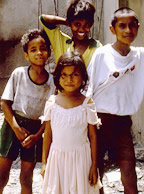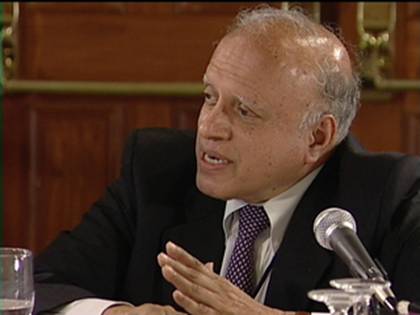| |
Philosophers
(many of
who are scientists too) muse over the purpose of life, we
live from day to day often, enjoying our personal ambitions,
chugging along, getting through life. Some of us ask the
question, “What is my purpose?” and some of us want to
know, “What can I give back to my community, to
society…”
If life
were equal and socialist, it may have been dull but when it
is so unequal that the GDP of 48 countries is less than the
assets of 3 of the richest people in the world, it is no
wonder that some of us are moved into thinking beyond our
daily, mundane existence.
At least one child below the age of 5 has died in the world while you
read this – of malnourishment – hunger, or diseases that
could have been prevented by immunization.

One
third of the world is near starvation, there are over 300
million malnourished children; can we just stop in our
tracks and ask ourselves some soul- searching questions.
At
primary school, in
Gwalior
when I was just 10 years
old, there was a boy who wore slippers and tattered clothes
and everybody laughed at him. He was married (!), he could
barely speak English and therefore the door to higher
education and eventually, employment, was slowly shutting.
It made me cry. I thank my father for showing me poor people
on the streets (and there are enough), talking of
deprivation and my Mother for doing the rounds of hospitals
with my scared housemaid who wanted to get a tubectomy done
but was frightened of doctors and the lack of after care
facilities that might have killed her and left her kids
bereft of the sole earner in the family.
Many of
us have seen our parents deprive themselves of something or
the other for us to be where we are. When my mother asked me
in an awed voice about whether the hotel I stayed in during
my trip to
Grand Canyon
had bedding and towels, I
was moved to tears. To ensure that we afford this quality of
life, our parents have made so many sacrifices. But not all
parents are as lucky, parents in slums and villages who are
prepared to spend around 40 % of their income on educating
their children – education that does not assure employment
despite their dreams, hopes and aspirations. Thousands join
the pool of ‘educated unemployed’ and are left to their
own devices. Often
the disconnect between education and job skills required
implies that the degree or diploma obtained proves useless
in getting a job. These energetic and aspiring youth take
longer and longer to achieve their expectations of leading a
life of dignity and self-esteem.
They are prone to becoming their own victims and are
likely fall through the cracks of hopelessness and short
cuts. This predicament and its outcome confront not only
their immediate family members, but also the community,
nations and the world as a whole. 44% people in
India
will sleep tonight having
earned less than a dollar. Think about that.
My
personal journey after studying involved observing
suffering, feeling miserable and wondering whether I could
do anything about it. At Hindustan Lever, when they sent us
for the IRD (integrated rural development) program, it was a
real eye-opener for me. Our chairman then was Mr. S M Dutta,
a very good man, a real visionary who believed that to sell
soap (and end of the day that’s what all of us are doing)
we also have to think about how people will become capable
of buying it. At Etah, I felt it is amazing to see how many
blessings we have that we don’t count and how much we take
for granted, from water to electricity, to basic
necessities, forget luxuries.
Corporate
Strategy is an interesting subject, if we were to write one
for ourselves, we might not feel like robots living from day
to day and it could give us some direction. Drop everything
else, ever pondered about your mission? As long as one felt
in Levers that one was selling soap and detergents, it was
not that great a feeling till we were apprised of our
mission, “Meeting the everyday needs of people
everywhere.” It absolutely revolutionizes how you define
your business or your life. A frustrated housewife could
redefine herself as House proud, involved in nutrition,
social security, and psychological comfort and make her feel
more valued by herself to start with.
Even if
we go by the Gita philosophy of us as evolving human beings,
(over lifetimes if there is some such thing), a strategic
vision helps. And if one were to put things in perspective
and redefine our values and our mission, (rather than seek
affirmation outside which often breeds discontent),
respecting work ethics, believing in the dignity of labor
and enhancing our lives through a social purpose are all
options available to us.
My
personal journey meant that the annual donation to CRY was
not sufficient and today, I have left the corporate world to
find meaning. It started with my sister’s drawing room has
a corner called the recycling corner – a different bin for
plastics, one for cardboard, one for magazines and so
on…which her son very proudly points out. She inspired my
research and subsequent book on the environment to improve
awareness amongst children in
India
and when I studied the
subject, I was aghast at the implications – sustainable
development sounds good in theory but to think that we could
destroy future civilizations, jeopardize the lives of our
children, it is scary. And to feel empowered by taking
little steps, the journey of a thousand miles begins with a
step – mine started with my book, “The Green Dragon”.
I think
of my child and whether she will ever experience the pain of
seeing the homeless or the poor in
USA
. And at the risk of sounding
strange, part of my children’s education will involve
being sensitized to this. I see materialism and I feel that
if only one were to give up a few indulgences, one might be
able to fund a child’s education or immunization.
My
journey has led me to Sunanda Mane and Raj Gilda and
that was the turning point in my life. Sunanda was Regional
Director with CARE in
India
and her simplicity and
vision are moving. She set up Lend a Hand India
(www.lend-a-hand-india.org) where I now work which deals
with issues of empowering students through vocational
training that will lead to jobs, self-employment and
community enhancement projects.
Working
with them has been an eye opener. Sunanda for instance told
me about a recent research on Indian philanthropy, the
glaring findings of which are that most donations that
Indians make go to temples and as little as 10-15% goes to
social projects. Can you imagine, at the cost of the poor,
ill, illiterate and hungry, funding RSS, Hindutva and
pundits who scare people into submission with superstitions
and feed themselves.
I feel
that for each of us, whether we are in the corporate sector,
or academics, or anywhere, there are options to make a
difference. I would welcome you viewing my NGO’s mission
and programs but everybody has a different agenda, something
that moves them. Whether they are related to technology or
gender issues or poverty or education or employment or the
environment or health or what have you. It could involve
research, getting involved with an NGO that one is convinced
about - and there are many doing a commendable job, and
doing anything from volunteering time to skills to writing
for them to donating, whatever. When I was involved in the
team writing about how one could contribute to LAHI, we
thought of number of different ideas – a fund raising
team, people involved in creative, website design and
development etc. (see http://www.lend-a-hand-india.org/Getting_Involved.htm).
There are many overlaps amongst NGO’s.
This is bound to exist, just like it does in the
private sector. And
competition is always good for the consumer – providing
choices and improving efficiency, keeping us on our toes.
 One
wonders whether and when there will be a critical mass of
people involved in these activities. But I believe there
will. I believe if each one of us tries to make a difference
to one program or even person, it snowballs. One of our
partner organizations in Pune was involved in implementing
Project Swadheen to provide vocational and life-skills
training to rural students and a Doctor who was their
beneficiary left everything and went back to his village to
implement the Project. Four other alumni have joined him.
There are enough examples of inspiring people from Manmohan
Singh, moved by poverty into becoming an economist, MS
Swaminathan (Green Revolution and now, ‘Every village
a knowledge center’), Ela
Bhatt (SEWA) and so many of our BITSians who are engaged
in social activities. One
wonders whether and when there will be a critical mass of
people involved in these activities. But I believe there
will. I believe if each one of us tries to make a difference
to one program or even person, it snowballs. One of our
partner organizations in Pune was involved in implementing
Project Swadheen to provide vocational and life-skills
training to rural students and a Doctor who was their
beneficiary left everything and went back to his village to
implement the Project. Four other alumni have joined him.
There are enough examples of inspiring people from Manmohan
Singh, moved by poverty into becoming an economist, MS
Swaminathan (Green Revolution and now, ‘Every village
a knowledge center’), Ela
Bhatt (SEWA) and so many of our BITSians who are engaged
in social activities.
There
are people who consider this a second career option, some a
feel good factor, some feel that they are giving something
back to their parents, their community, whatever the motive
might be, a person somewhere could benefit, or an animal,
somebody hungry, dying or destitute. Let’s make the world
a better place.
As
a girl involved in one of our programs said, very simply and
eloquently, “I feel like I am flying a kite and I want to
touch the sky.”
Photograph courtesy © Nadine
Sloan (Glenaire). Source - www.ncdoi.com/■
|
(c) Copyright 2004 BITSAA International Inc. |
|
Website
by jPeople, YonEarth
and BITSAA Technology |
|

